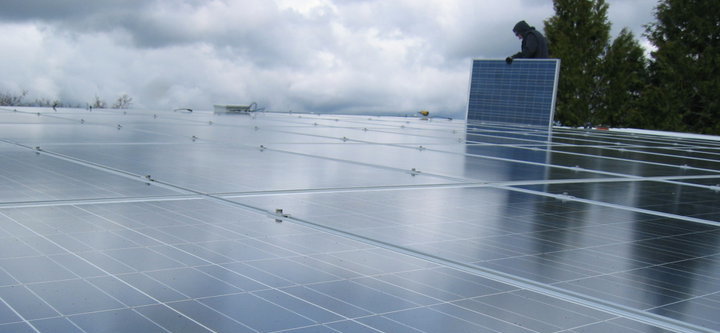With California experiencing one of the worst droughts in recorded history, it’s a great time to explore converting to solar. Not only can solar power help put the brakes on climate change, it’s also one of the least “thirsty” methods of generating electricity. According to Diamond Certified solar company Sungevity, coal-fired power plants require 100 to 1,000 gallons of water to generate one megawatt-hour of electricity. Solar, by comparison, requires zero gallons of water to produce the same amount of electricity (more details). With this in mind, we’re re-posting this timely article on how to get started with a residential solar power system.

Keeping your solar panels in good shape is actually relatively simple. Photo: Synapse Electric, 2015
People have many reasons for switching to solar power, from rising electricity consumption and energy costs to growing concerns about the environment. Regardless of why you want to install a solar system on your residential or commercial property, there are numerous factors to consider before making a final decision. To ensure you’re as knowledgeable as possible when going through the process, consider the following tips and information:
Make sure you understand your utility company’s rates. In many areas, there are different “tiers” of usage and each has a different formula to calculate cost. Higher energy usage tiers have higher rates. In these schemes, you pay more as your energy demands increase. In the Bay Area, the typical monthly PG&E bill is around $90, but when your monthly bill exceeds $237, you’re at “Tier 5” and pay higher rates. However, when you switch to solar power with PG&E as your utility, it removes the top tiers from the cost formula. Therefore, the more you currently spend on electricity, the higher the ROI (return on investment) you’ll enjoy on an installed solar system.
Get an accurate idea of the amount of energy your home uses each month. A growing family will face growing energy needs, but if you’re childless or have college-age kids, you can expect your energy costs to go down and stay down. Replacing incandescent bulbs and making other energy-saving changes and upgrades can lower your costs even further. Have a solar installer calculate your planned electricity demands, not your current usage.
Will solar add to your property tax? Adding a solar system won’t cause a reassessment of your property. Reassessments are trigged by room additions and other construction that increases the square footage of the structure. If a property assessment is triggered in California, the addition of solar panels is exempt from property taxes.
Cover your solar investment. After installation, contact your homeowner’s insurance company and have your policy amended. You’ll face an increase on your property insurance of around $10 per month, but your system will be protected from fires and other damage.
Become familiar with your solar warranties. Two kinds of warranties are normally offered on solar systems. The first is the panel and inverter manufacturer warranty, which is usually 20 to 25 years on panels and five to 10 years on the inverters. The second is a workmanship warranty, which should be provided by your installer and cover roof holes and leaks for two to 10 years.
How long do solar panels last? Generally speaking, solar panels will last 30 years or more and lose about 0.5 percent conversion efficiency annually. Hosing the panels off a few times during the summer and keeping leaves off them in the fall is about the only maintenance required.
Will solar panels harm your roof? If properly installed, solar panels won’t harm your roof in any way. They actually protect the areas located beneath them from the ravages of weather, light and heat. You may even find that the rooms directly beneath the panel installations will remain cooler in summer and warmer in winter, regardless of the other insulation.
To find a Diamond Certified solar company in your area, click one of the links below.
Alameda County: www.diamondcertified.info/alameda-solar
Contra Costa County: www.diamondcertified.info/contra-costa-solar
Marin County: www.diamondcertified.info/marin-solar
San Francisco: www.diamondcertified.info/san-francisco-solar
San Mateo County: www.diamondcertified.info/san-mateo-solar
Santa Clara County: www.diamondcertified.info/santa-clara-solar
Santa Cruz County: www.diamondcertified.info/santa-cruz-solar
Sonoma County: www.diamondcertified.info/sonoma-solar
